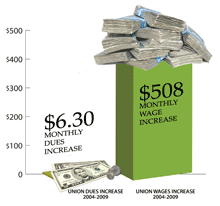Constitution calls for monthly union dues to increase by twice that amount
THE BUREAU OF LABOR Statistics (BLS) has announced a 1.7 percent average increase in hourly earnings for the manufacturing industry from July 2009 to July 2010. As a result, the International will raise its per capita tax in 2011 by 1.7 percent (40 cents), and monthly union dues will increase by twice that amount ($0.80), effective Jan. 1, 2011.
Compared to wage increases, union dues increases are minimal
Union members make nearly $800 more a month than their nonunion counterparts
FROM 2004 TO 2009, the average monthly wage for unionized workers in the manufacturing industry increased by $508 — from $3,124 to $3,632, while the monthly union dues paid by Boilermakers increased by only $6.30. In the same period, nonunion wages increased by only $392 a month, from $2,448 to $2,840. This means union members in 2009 made an average of $792 more per month in wages alone than their nonunion counterparts ($3,632 vs. $2,840).
Source: Bureau of Labor Statistics, Union Members in 2004, -2009, Earnings. (2010 figures not available at time of printing.)
These increases are in accordance with the Boilermakers’ Constitution. Article 12.2.2 states the monthly per capita tax will be adjusted annually by the BLS average percent increase in earnings for manufacturing, rounded to the nearest nickel. Article 31.2.2 states that monthly union dues will increase by twice the annual adjusted per capita tax increase.
Applying the 2009-2010 BLS 1.7 percent increase to the 2010 per capita tax rate of $22.75 equals $0.3867 (40 cents when rounded to the nearest nickel), making the 2011 per capita tax rate $23.15 effective Jan. 1.
Monthly union dues vary by division, but the average rate will increase by twice the annual adjusted per capita tax increase (two x 40 cents = $0.80).
The automatic dues increase was created by convention action in 1973 and has been in effect since 1975 so that revenue will keep up with inflation. Prior to that time, convention delegates had to vote for all dues increases. When they met only every four years, that meant they had to try to predict wage growth and expense growth over the next four years (now it’s five). By making the increase automatic and pegging it to rising wages, they ensured rises in revenue kept pace with inflation and did not create a hardship on members, since the increases were linked to wages.






